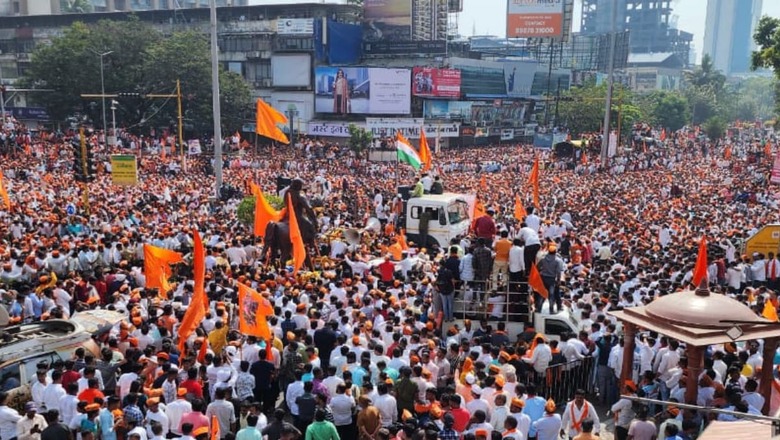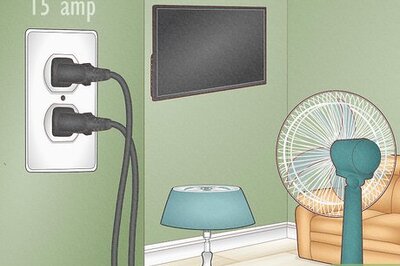
views
The Maharashtra government today extended 10% reservation to Marathas in the socially and economically backward category in jobs and educational institutes. With this, the total reservation in Maharashtra will go up to 62%.
Chief minister Eknath Shinde said reservation to Marathas will be given according to the terms of law after presenting a report during the special assembly session.
The report was submitted to the state government by Maharashtra Backward Class Commission (MBCC) headed by chairman Justice (Retired) Sunil Shukre. The commission had conducted a survey of 2.5 crore homes within nine days and compiled a report on social and educational backwardness of the Maratha community.
What Has Happened So Far?
The reported puts onus on the government to extend reservation to the Marathas.
The Devendra Fadnavis government in Maharashtra in 2017 had constituted the MBCC to study the social, financial and educational status of Marathas.
The commission submitted the report in November 2018, classifying Marathas as a socially and educationally backward class (SEBC). The same month, the Maharashtra assembly passed a bill proposing 16% reservation in education and government jobs for Marathas.
The Bombay High Court then upheld the constitutional validity of the reservation law, and reduced the quota to 12% in educational institutes and 13% in jobs.
The Supreme Court’s five-judge Constitution Bench then took up the matter and unanimously agreed that there was no need to revisit the 1992 Indra Sawhney judgment that fixed reservation limit to 50%. The SC struck down the state law granting quota to Marathas.
Who are the Stakeholders Involved?
Maratha activist Manoj Patil Jarange came to limelight after his hunger strike in September last year. He started his protest march from Jalna district accompanied by thousands of supporters. He originally hails from Beed district and settled in Shahgad in Jalna district.
He joined the Maratha quota stir around 15 years ago. He also sold 2.5 acres of agricultural land out of his 4 acres to meet his daily requirements.
After working for the Congress for quite some time, he founded an outfit called Shivba Sanghatana to organise protests.
Maharashtra minister and Nationalist Congress Party (NCP) leader Chhagan Bhujbal and several other prominent OBC leaders including Congress leaders Vijay Wadettiwar, Rajesh Rathod, Bharatiya Janata Party (BJP) MLC Gopichand Padalkar, Prakash Shendge and Rashtriya Samaj Paksha (RSP) leader Mahadev Jankar participated in the protest, showing their support to the quota demand.
NCP’s Chhagan Bhujbal, who resigned as cabinet minister from the Eknath Shinde government, has been opposing the reservation as including the Marathas would be lead to the OBC category getting crowded for reservation.
Meanwhile, chief minister Eknath Shinde, who has assured the protestors of the quota, had last year said the government is actively engaged in issuing Kunbi certificates to Marathas from Marathwada to enable them to access OBC benefits, and ensure submission of curative petition in the Supreme Court is free of errors.
Who are the Marathas?
The Marathas held the first protest demanding reservation in government jobs and education around 32 years ago.
From landowners to peasants to warriors, Marathas form 33% of Maharashtra’s population. The Maratha Kshatriyas mostly have surnames like Deshmukh, Bhonsle, More, Shirke and Jadhav. Others belong to the Kunbi community, a predominantly agrarian sub-caste.
The difference between the Maratha Kshatriyas and Kunbis existed till the time of the Maratha empire. Now, most of the Marathas are engaged in farming activities.
While all Marathas are Marathis, not all Marathis are Marathas. Maratha signifies a group of castes, while Marathi is the language spoken by several communities in Maharashtra and some neighbouring areas of other states.
Kunbi, an agrarian community that falls under the OBC category, has been demanding Kunbi certificates for all Marathas.
What will Change?
Reports suggest that the bill for 10% Maratha quota is similar to the Socially and Educationally Backward Classes Act, 2018, introduced by the Fadnavis government.
The state already has a 10% quota for the Economically Weaker Section (EWS) in which politically influential Marathas are biggest beneficiaries, claiming 85% of the reservation.
This is the third time in three decades that the state is introducing the legislation for the Maratha quota. Every time the legislation was introduced, it has been before an election and the survey was conducted that concluded that the community is backward.
Meanwhile, the OBC community fears dilution of its quota if the Kunbis are included in it. OBC groups such as the Rashtriya OBC Mahsangh have already said they will challenge the Maratha quota legislation in court.













Comments
0 comment